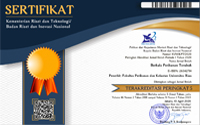Isolation and Identification of Disease-Causing Fungi in Tilapia (Oreochromis niloticus) and Catfish (Clarias gariepinus) Seeds
Abstract
Keywords
Full Text:
PDFReferences
Alawi, H. dan U. M. Tang. 2017. Akuakultur Lanjutan. Wisma Kalimetro, Malang
Hapsari, A. 2014. Isolation and Identification of Fungi in Chef Carp (Carassius auratus) at the Gunung Sari Ornamental Fish Exchange in Surabaya, East Java. [ESSAY]. Airlangga University, Surabaya.
Hastuti, Y. P. 2013. Mengenal Pengaruh Cendawan dalam Lingkungan Budidaya. Departemen Budidaya Perairan. Institut Pertanian Bogor, Bogor
Jasmanindar, Y. 2011. Prevalence of Parasites and Freshwater Fish Diseases cultivated in Kupang City/Regency. Journal of Life and Physical Sciences, 13 (1): 25-30. ISSN: 1411-0903.
Khairyah, U., R. Kusdarwati and Kismiyati. 2013. Identification and Prevalence of Fungi in Gurami (Osphronemus gouramy) in Ngrajek Village, Mungkit District, Magelang District, Central Java. Airlangga University, Surabaya.
Kidd, S., C. Halliday, H. Alexiou and D. Ellis. 2016. Description of Medical Fungi. University of Adelaide, Australia.
Kordi, K. 2004. Prevention of Fish Pests and Diseases. Bina Adiaksara, Jakarta.
Kurniawan, A. 2012. Aquatic Animal Disease. Bangka Belitung Press University, Bangka Belitung.
Nevarez, L., V. Vasseur., A. LeMadec., M. A. Lebras., L. Coroller., I. Leguerinel., G. Barbie. 2009. Physiological Traits of Penicillium Strain LPC 08.5568, a Filamentous Fungus Isolated from Bottled Aromatised Mineral Water. Journal of Food Microbiology. 130(3):166-171.
Nyongesa, BW, S. Okoth and V. Ayugi.2015.Identification Key of Aspergillus Species Isolated from Maize and Soil of Nandy County, Kenya. University of Nairobi, Kenya.
Summerbell, R.C., S.A. Rosenthal and J. Kane. 1988. Rapid method for Differention of Trichophyton rubhum, Trichophyton mentagrophytes, And related derma tophyte species. Journal of Clinical Microbiology, 26:2279-2282.
Weitzman, I., J. Kane. 1991. Dermatophytes and Agents of Superficial Mycoses, pp. 601-616. In a Ballows, WJ Hausler jr., KL Hermann, HD Isenberg, HJ Shadomy. Manual of Clinical Mycrobiology. American Society for Mycrobiology, Washington.
Wogu, M. D., and A. D. Lyayi, 2011. Mycoflora of Some Smoked Fish Varieties In Benin City Nigeria. Ethiopian Journal of Environmental Studies and Management (4):1-3.
DOI: http://dx.doi.org/10.31258/terubuk.49.1.767-774
Refbacks
- There are currently no refbacks.
Copyright (c) 2021 Indra Lesmana, Nur Arlia Yusnita, Andri Hendrizal

This work is licensed under a Creative Commons Attribution 4.0 International License.












